
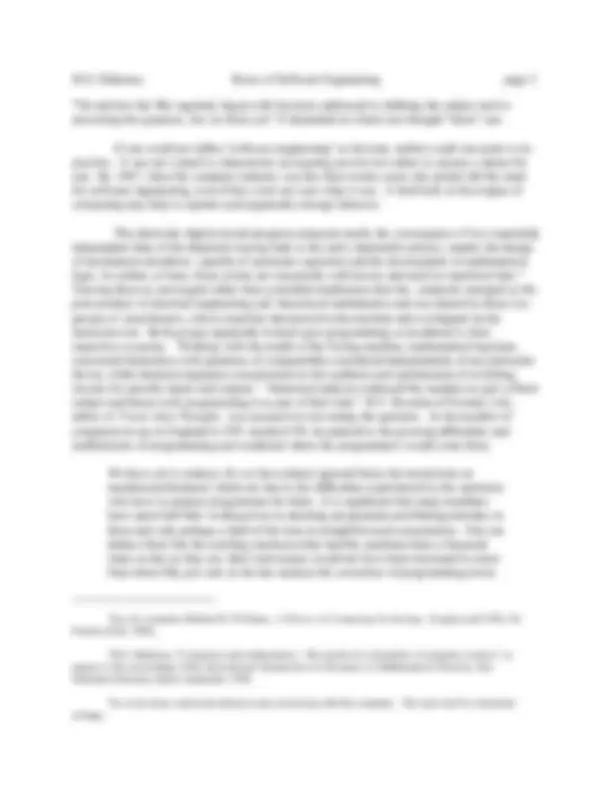
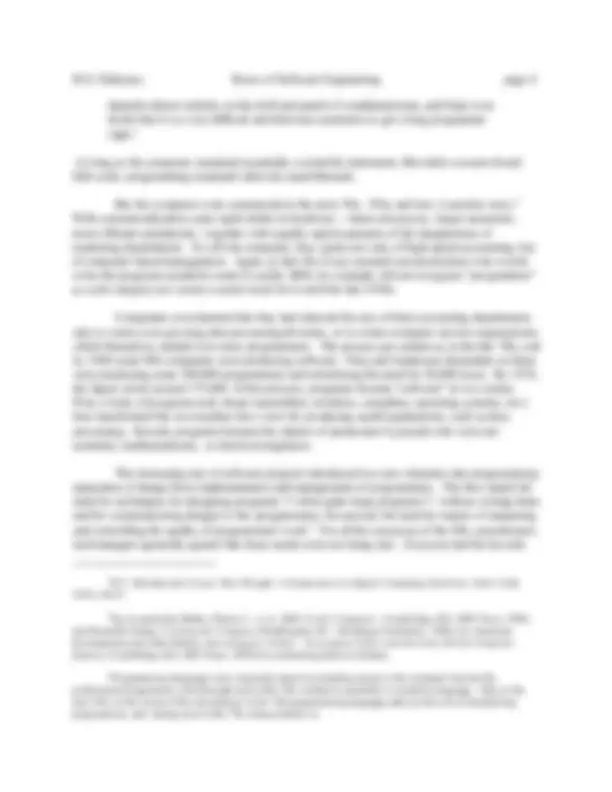
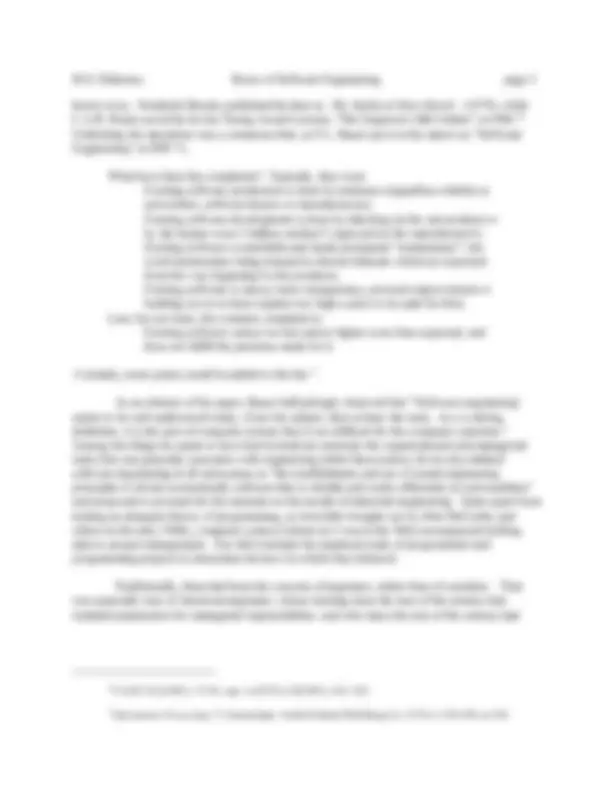
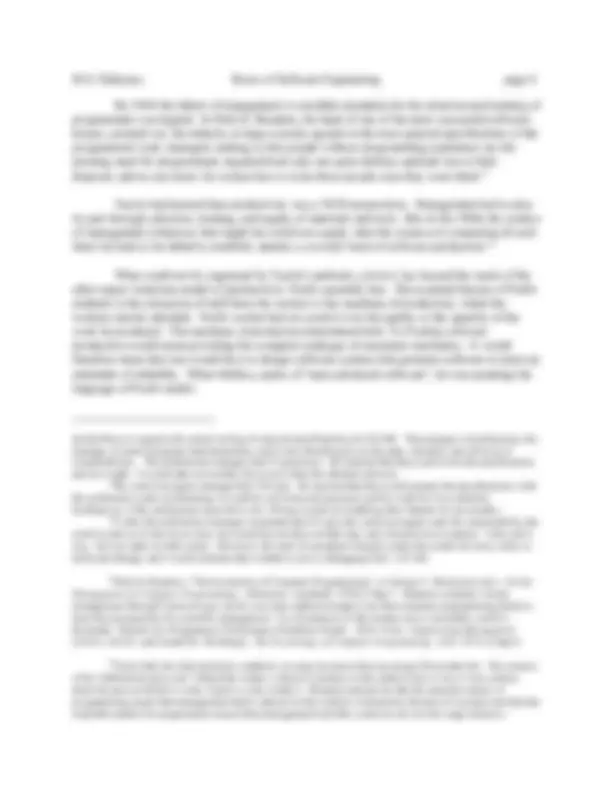
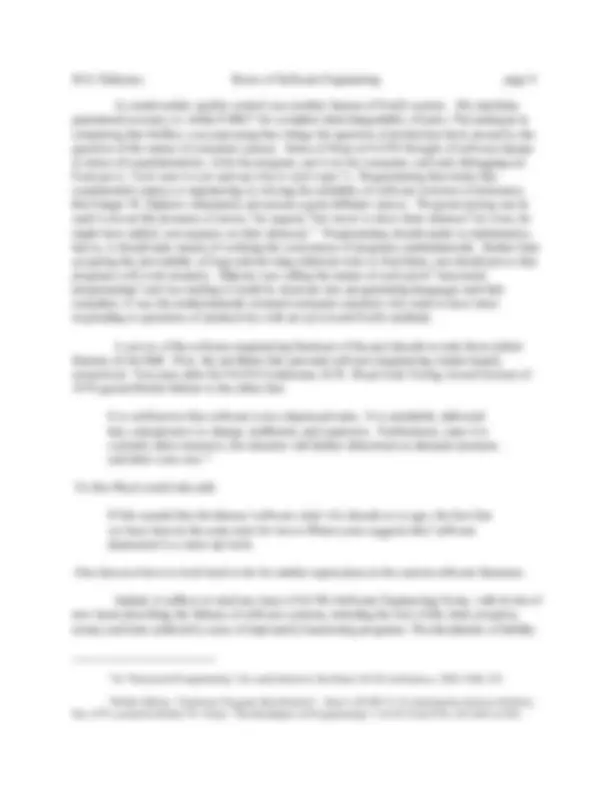
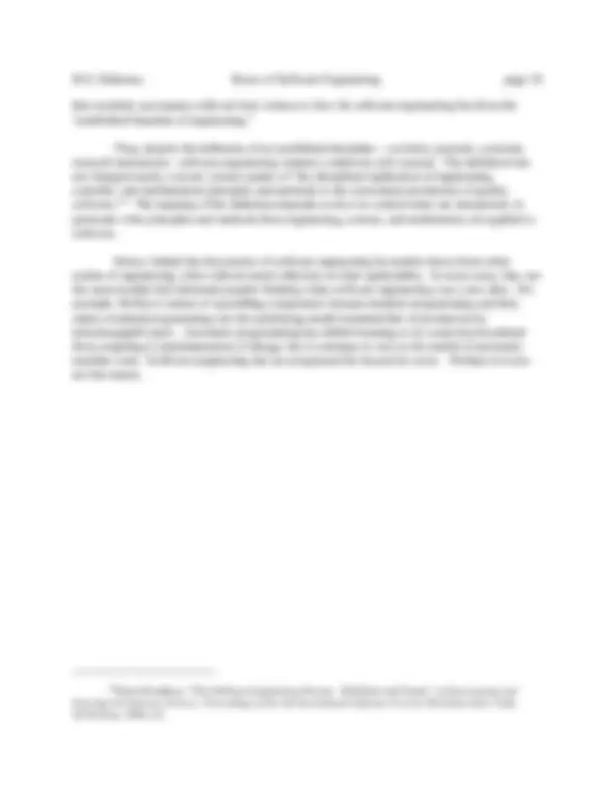


Study with the several resources on Docsity

Earn points by helping other students or get them with a premium plan


Prepare for your exams
Study with the several resources on Docsity

Earn points to download
Earn points by helping other students or get them with a premium plan
Community
Ask the community for help and clear up your study doubts
Discover the best universities in your country according to Docsity users
Free resources
Download our free guides on studying techniques, anxiety management strategies, and thesis advice from Docsity tutors
The early debates surrounding the concept of software engineering in the late 1950s and 1960s. The authors question what theoretical foundations and practical disciplines were being referred to when the term 'software engineering' was first used. They discuss the differences in perspective among practitioners, with some viewing software engineering as an applied science, others as a body of design techniques, and still others as a matter of organization and management. The document also touches upon the need for software manufacturing and the challenges faced in the industry at the time, such as unreliable software, lack of transparency, and high costs.
What you will learn
Typology: Schemes and Mind Maps
1 / 10

This page cannot be seen from the preview
Don't miss anything!







*An expan ded version of a lecture presented at CWI on 1 February 1990. It is based on r esearch
generously supported by the Alfred P. Sloan Foundation.
(^1) Published in N. Metropolis, J. Howlett, G.-C. Rota (eds.), A History of Computing in the Twentieth
Century: A Collection of Essays (N.Y.: Academic Press, 1980), 3-9.
Michael S. Mahoney Princeton University
( CWI Quarterly 3,4(1990), 325-334)
At the International Conference on the History of Computing held in Los Alamos in 1976, R.W. Hamming placed his proposed agenda in the title of his paper: "We Would Know What They Thought When They Did It."^1 He pleaded for a history of computing that pursued the contextual development of ideas, rather than merely listing names, dates, and places of "firsts". Moreover, he exhorted historians to go beyond the documents to "informed speculation" about the results of undocumented practice. What people actually did and what they thought they were doing may well not be accurately reflected in what they wrote and what they said they were thinking. His own experience had taught him that.
Historians of science recognize in Hamming's point what they learned from Thomas Kuhn's Structure of Scientific Revolutions some time ago, namely that the practice of science and the literature of science do not necessarily coincide. Paradigms (or, if you prefer with Kuhn, disciplinary matrices) direct not so much what scientists say as what they do. Hence, to determine the paradigms of past science historians must watch scientists at work practicing their science. We have to reconstruct what they thought from the evidence of what they did, and that work of reconstruction in the history of science has often involved a certain amount of speculation informed by historians' own experience of science. That is all the more the case in the history of technology, where up to the present century the inventor and engineer have *-as Derek Price once put it*- "thought with their fingertips", leaving the record of their thinking in the artefacts they have designed rather than in texts they have written.
Yet, on two counts, Hamming's point has special force for the history of computing. First, whatever the theoretical content of the subject, the main object of computing has been to do something, or rather to make the computer do something. Successful practice has been the prime measure of effective theory. Second, the computer embodies a historically unique relation of thinking and doing. It is the first machine for doing thinking. In the years following its creation and its introduction into the worlds of science, industry, and business, both the device and the activities involved in its use were new.
It is tempting to say they were unprecedented, were that not to beg the question at hand. Precedents are what people find in their past experience to guide their present action. Conversely, actions usually reflect the guidance of experience. Nothing is really unprecedented. Faced with a
(^2) Brian Randell ("Software Engineering in 1968", Prof. 4th Intern. Conf. on Software Engineering
[Munich, 1979], 1) ascribes it to J.P. Eckert at th e Fall Joint Computer Conference in 1965, but th e transcript of the one panel discussion in which Eckert participated shows no evidence of the term "software engineering". D.T. Ross claims the term was used in courses he was teach ing at MIT in the late '50s; cf. "Int erview: Douglas Ross Talks About Structured Analysis", Computer (July 1985), 80-88.
(^3) Peter Naur, Brian Randell, J.N. Buxton (eds.), Software Engineering: Concepts and Techniques (NY:
Petrocelli/Charter, 1976; hereafter NRB ).
new situation, people liken it to familiar ones and shape their response on the basis of the perceived similarities. In the case of the computer, what was new was the reliable electronic circuitry that made its underlying theoretical structure realizable in practice. At heart, it was a Turing Machine that operated within the constraints of real time and space. That much was unprecedented. Beyond that, precedent shaped the computer. The Turing Machine was an open schema for a potentially infinite range of particular applications. How the computer was going to be used depended on the experience and expectations of the people who were going to use it or were going to design it for others to use.
As part of a history of the development of the computer industry from 1950 to 1970 focusing on the origins of t he "software crisis", I am currently trying to determine what people had in mind when they first began to talk about "software engineering". Although one writer has suggested that the term originated in 1965,^2 it first came into common currency in 1967 when the Study Group on Computer Science of the NATO Science Committee called for an international conference on the subject. As Brian Randell and Peter Naur point out in the introduction to their edition of the proceedings, "The phrase 'software engineering' was deliberately chosen as being provocative, in implying the need for software manufacture to be [based] on the types of theoretical foundations and practical disciplines[,] that are traditional in the established branches of engineering."^3
It is not entirely clear just what the Study Group meant to provoke, since that statement opens several areas of potential disagreement. Just what are the "types of theoret ical foundations and practical disciplines that are traditional in the established branches of engineering"? What would their counterparts look like for soft ware engineering? What role does engineering play in manufacture? Could one assign such a role to software engineering? Can software be manufactured? Clearly, the Study Group thought the answer to the last question was yes, but it offered no definitive answers to the others, and the proceedings of the conference, along with the literature since, reveal a range of interpretations among the practitioners who were to become software engineers.
Their differences extended beyond the realm of software to the nature of engineering itself. What some viewed as applied science, others took to be a body of techniques of design, while still others thought in terms of organization and management. Each point of view encompassed its own models and touchstones, in most cases implicitly and perhaps even unconsciously. Small wonder t hat conferences and symposia on software engineering through the
(^7) B.V. Bowden (ed.) Faster That Thought: A Symposium on Digital Computing Machines (New York,
1953), 96-97.
(^8) See in particular Bashe, Charles J. et al., IBM's E arly Computers (Cambridge, MA: MIT Press, 1986)
and Kenneth Flamm, Creating the Computer (Washington, DC: Brookings Institution, 1988), for American developments and John Hendry, Innovating for Failure. Government Policy and the Early British Computer Industry (Cambridge, MA: MIT Press, 1989) for contrasting efforts in Britain.
(^9) Programming languages were originally aimed at extending access to the computer beyond the professional programmer, who through most of the '60s worked in assembler or machine language. Only in the later '60s, in the course of the developing "crisis" did programming languages take on the role of disciplining progr ammers, and during most of the '70s unsuccessfully so.
depends almost entirely on the skill and speed of a mathematician, and there is no doubt that it is a very difficult and laborious operation to get a long programme right.^7
As long as the computer remained essentially a scientific instrument, Bowden's concern found little echo; programming remained relatively unproblematic.
But the comput er went commercial in the early '50s. Why and how is another story.^8 With commercialization came rapid strides in hardware -- faster processors, larger memories, more efficient peripherals-- together with equally rapid expansion of the imaginations of marketing departments. To sell the computer, they spoke not only of high-speed accounting, but of computer-based management. Again, at first few if any seemed concerned about who would write the programs needed to make it useful. IBM, for example, did not recognize "programmer" as a job category nor create a career track for it until the late 1950s.
Companies soon learned that they had reduced the size of their accounting departments only to create ever-growing data processing divisions, or to retain computer service organizations which themselves needed ever more programmers. The process got underway in the late '50s, and by 1968 some 500 companies were producing software. They and businesses dependent on them were employing some 100,000 programmers and advertising the need for 50,000 more. By 1970, the figure stood around 175,000. In this process, programs became "software" in two senses. First, a body of programs took shape (assemblers, monitors, compilers, operating systems, etc.) that transformed the raw machine into a tool for producing useful applications, such as data processing. Second, programs became the objects of production by people who were not scientists, mathematicians, or electrical engineers.
The increasing size of software projects introduced two new elements into programming: separation of design from implementation and management of programmers. The first raised the need for techniques for designing programs *-often quite large programs*- without writing them and for communicating designs to the programmers; t he second, the need for means of measuring and controlling the quality of programmers' work.^9 For all the successes of the '60s, practitioners and managers generally agreed that those needs were not being met. Everyone had his favorite
(^10) CACM 24,2(1981), 75-83; repr. in BYTE 6,10(1981), 414- 425.
(^11) Information Processing 71 (Amsterdam: North-Holland Publishing Co, 1972), I, 530-538; at 530.
horror story. Frederick Brooks published his later as The Mythical Man-Month (1975), while C.A.R. Hoare saved his for his Turing Award Lecture, "The Emperor's Old Clothes" in 1980.^10 Underlying the anecdotes was a consensus that, as F.L. Bauer put it in his report on "Software Engineering" at IFIP 71,
What have been the complaints? Typically, they were: Existing software production is done by amateurs (regardless whether at universities, software houses or manufacturers), Existing software development is done by tinkering (at the universities) or by the human wave ("million monkey") approach at the manufacturer's, Existing software is unreliable and needs permanent "maintenance", the word maintenance being misused to denote fallacies which are expected from the very beginning by the producer, Existing software is messy, lacks transparency, prevents improvement or building on (or at least requires too high a price to be paid for this). Last, but not least, the common complaint is: Existing software comes t oo late and at higher costs than expected, and does not fulfill the promises made for it.
Certainly, more points could be added to this list.^11
As an abstract of his paper, Bauer half-jokingly observed that "'Software engineering' seems to be well understood today, if not the subject, then at least the term. As a working definition, it is the part of computer science that is too difficult for the computer scientists." Among the things he seems to have had in mind are precisely the organizational and managerial tasks that one generally associates with engineering rather than science, for he also defined software engineering in all seriousness as "the establishment and use of sound engineering principles to obtain economically software that is reliable and works efficiently on real machines" and proposed to proceed for the moment on the model of industrial engineering. Quite apart from lacking an adequate theory of programming, as forcefully brought out by John McCarthy and others in the early 1960s, computer science (whatever it was in the '60s) encompassed nothing akin to project management. Nor did it include t he empirical study of programmers and programming projects to determine the laws by which they behaved.
Traditionally, these had been the concern of engineers, rather than of scientists. That was especially true of American engineers, whose training since the turn of the century had included preparation for managerial responsibilities and who since the turn of the century had
(^13) Frederick Winslow Taylor, The Principles of Scientific Management (1911; repr. N.Y.: Norton, 1967),
36-
(^14) In The Mythical Man-Month: Essays in Software Engineering (Reading, MA, 1975), Frederick P.
Brooks, Jr., manager of IBM's OS/360 project, recounted his own failures in this regard: "It is a very humbling experience to make a mul timi llion -dollar mistake, but it is a lso very memora ble. I vividly recall the n ight we
Moreover, with each advance in precision and automatic operation, machine tools made ever tighter management possible by relocating the machinist's skill into the design of the machine. Increasingly toward the end of the 19th century, workers could be held to close, prefixed standards, because those standards were built into the tools of production. That trend culminated in Ford's machines of production, which automatically produced parts to the tolerances requisite to interchangeability.
As McIlroy knew, mass production was as much a matter of management as of technique. It was not only the sophistication of the individual machines, but also the system by which they were linked and ordered, that transformed American industry. Two figures loomed large in that transformation: Frederick W. Taylor and Henry Ford. The first was associated with "scientific management", t he forerunner of modern management science, the latter with the assembly line.
Yet, viewed more closely in light of what was revealed at Garmisch, Taylor's basic principles themselves cast doubt on the applicability of his model to the production of software. The primary obligation of management according t o Taylor was to determine the scientific basis of the task to be accomplished. That came down to four main duties:
First. They develop a science for each element of a man's work, which replaces the old rule-of-thumb method. Second. They scientifically select and then train, teach, and develop the workman, whereas in the past he chose his own work and trained himself as best he could. Third. They heartily cooperate with the men so as to insure all of the work [is] being done in accordance with the principle of the science which has been developed. Fourth. There is an almost equal division of the work and the responsibility between the management and the workmen. The management take over all work for which they are better fitted than the workmen, while in the past almost all of the work and t he greater part of the responsibility were thrown upon the men.^13
To what extent computer science could replace rule of thumb in the production of software was precisely the point at issue at the NATO conferences. Even the optimists agreed that progress had been slow. Unable, then, to fulfil the first duty, programming managers were hardly in a position to carry out the third. Everyone bemoaned the lack of standards for the quality of software. As far as the fourth was concerned, few ventured to say who was best suited to do what in large-scale programming project.^14
decided how to organize the actual writing of external specifications for OS/360. The manager of architecture, the manager of contr ol prog ram implement ation , and I were t hreshin g [!] out the plan , schedule, and divisi on of responsibilities. The architecture manager had 10 good men. He asserted that they could write the specifications and do it right. It would take ten months, thr ee more than the schedule allowed. "The control program manager had 150 men. He asserted that they could prepare the specifications, with the architecture team coordinating; it would be well done and practical, and he could do it on schedule. Furtherm ore, if the architecture team did it, his 150 men would sit twiddli ng their thumbs for ten month s. "To this the architecture manager responded that if I gave the control program team the responsibility, the result would not in fact be on time, but would also be three months late, and of much lower quantity. I did, and it was. He was right on both counts. Moreover, the lack of conceptual integrity made the system far more costly to build and change, and I would estimate that it added a year to debugging time." (47-48)
(^15) Dick H. Brandon, "The Economics of Computer Programming", in George F. Weinwurm (ed.), On the
Management of Computer Programming (Princeton: Auerbach , 1970), C hap.1. Brandon evidently viewed management through Taylorist eyes, but he was clear-sighted enough to see that computer programming failed to meet the prerequisites for scientific management. For an analysis of why testing was so unreliable, see R.N. Reinstedt, "Results of a Programmer Performance Prediction Study", IEEE Trans. Engineering Management (12/67), 183-87, and Gerald M. Weinberg's The Psychology of Computer Programming (NY, 1971), Chap.9.
(^16) Taylor had also laid pa rticula r empha sis on wage structures th at encoura ge full production. Th e essence
of his "different ial piece ra te" offered the worker a choice to produce a t the optim al rate or not; it was a choice about the pace at which to work, T aylor's or th e worker 's. Br andon poin ted out that the anarchic nature of programming meant that management had to depend on the workers to determine the pace of a project and that the insati able market for progra mmers mea nt that man agement h ad littl e control at all over the wage structur e.
By 1969 the failure of management to establish standards for the selection and training of programmers was legend. As Dick H. Brandon, the head of one of the more successful software houses, pointed out, the industry at large scarcely agreed on the most general specifications of the programmer's t ask, managers seeking to hire people without programming experience (as the pressing need for programmers required) had only one quite dubious aptitude test at their disposal, and no one knew for certain how to train those people once they were hired.^15
Taylor had insisted that productivity was a 50/50 proposition. Management had to play its part through selection, training, and supply of materials and tools. But in the 1960s the science of management (whatever that might be) could not supply what the science of computing (if such there be) had so far failed to establish, namely a scientific basis of software production.^16
What could not be organized by Taylor's methods a fortiori lay beyond the reach of the other major American model of productivity: Ford's assembly line. The essential feature of Ford's methods is the relocation of skill from the worker to the machines of production, which the workers merely attended. Ford's worker had no control over the quality or the quantity of the work he produced. The machines of production determined both. To Fordize software production would mean providing the computer analogue of automat ic machinery. It would therefore mean that one would have to design software systems that generate software to meet set standards of reliability. When McIlro y spoke of "mass-produced software", he was speaking the language of Ford's model.
(^19) Watts Humphrey, "The Software Engineering Process: Definition and Scope", in Representing and
Enacting the Software Process: Proceedings of the 4th International Software Process Workshop (New York: ACM Press, 1989), 82.
that routinely accompany software bear witness to how far software engineering lies from the "established branches of engineering."
Thus, despite the hallmarks of an established discipline -- societies, journals, curricula, research institutions-- software engineering remains a relatively soft concept. The definition has not changed much; a recent version speaks of "the disciplined application of engineering, scientific, and mathematical principles and methods to the economical production of quality software."^19 The meaning of the definition depends on how its central terms are interpreted, in particular what principles and methods from engineering, science, and mathematics are applied to software.
Hence, behind the discussions of software engineering lie models drawn from other realms of engineering, often without much reflection on their applicability. In most cases, they are the same models that informed people's thinking when software engineering was a new idea. For example, McIlroy's notion of assembling components became modular programming and then object-oriented programming, but the underlying model remained that of production by interchangeable parts. Automatic programming has shifted meaning as its scope has broadened from compiling to implementation of design, but it continues to rest on the model of automat ic machine tools. Software engineering has not progressed far beyond its roots. Perhaps its roots are the reason.